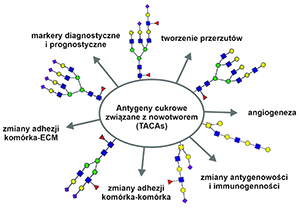The role of glycans in cancer development and progression. Clinical applications
DOI:
https://doi.org/10.18388/pb.2021_385Abstract
Changes in glycosylation pattern of cell surface, body fluids and extracellular matrix glycoconjugates is a characteristic feature of tumor cell malignancy. These changes are the result of mutations of tumor-associated genes as well as epigenetic changes in the tumor environment, including nutrient influx, hypoxia, cytokine expression and stimulation of chronic inflammation. The unique set of cell surface glycoantigens on neoplastic cells is recognized by endogenous lectins located in the extracellular matrix, vascular endothelium, on leukocytes or platelets, and has an impact on disrupting basic cellular processes, such as intercellular recognition, cell-cell adhesion or cell-ECM interaction. These changes have a critical impact on the migration, invasive and metastatic potential of neoplastic cells and modulate the immune response. This unique pattern of sugar antigens on the cancer cells can be a vaulable marker to identify them, determine the stage of the disease as well as be a target of anti-cancer therapy.

Published
Issue
Section
License
Copyright (c) 2021 Advances in Biochemistry

This work is licensed under a Creative Commons Attribution 4.0 International License.
All journal contents are distributed under the Creative Commons Attribution-ShareAlike 4.0 International (CC BY-SA 4.0) license. Everybody may use the content following terms: Attribution — You must give appropriate credit, provide a link to the license, and indicate if changes were made, ShareAlike — If you remix, transform, or build upon the material, you must distribute your contributions under the same license as the original. There are no additional restrictions — You may not apply legal terms or technological measures that legally restrict others from doing anything the license permits.
Copyright for all published papers © stays with the authors.
Copyright for the journal: © Polish Biochemical Society.



